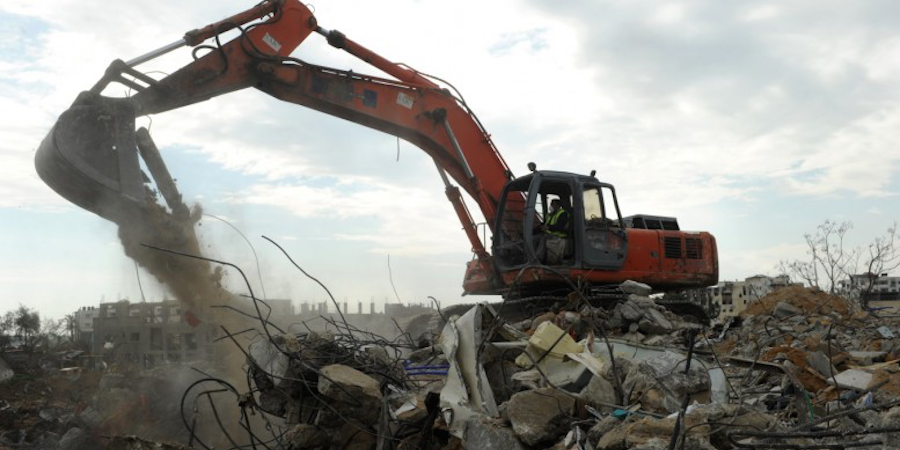The UN Office for the Coordination of Humanitarian Affairs (OCHA) discusses what to expect in 2017 as East Jerusalem, the West Bank and Gaza mark 50 years under Israeli occupation.
“The humanitarian context of [the occupied Palestinian territories (OPT)] is unique amongst today’s humanitarian crises and remains directly tied to the impact of occupation, now in its 50th year,” begins a report on the humanitarian needs of the Palestinian people by the United Nations Office for the Coordination of Humanitarian Affairs (OCHA).
Based on an overview of the humanitarian crisis facing Palestine, OCHA concludes that about one in two Palestinians will require humanitarian assistance in 2017. It also identifies all 4.8 million Palestinians in the OPT as “affected by protection threats.”
The OPT includes East Jerusalem, the West Bank, and the Gaza Strip.

People in Need in the OPT, OCHA, 2016.
The Gaza Strip
Out of the approximately 2 million Palestinians living in the OPT currently in need of humanitarian assistance, 1.2 million reside in Gaza. The area’s special vulnerability stems from periodic Israeli assaults as well as the decade long Israeli siege on the coastal enclave.
Gaza’s humanitarian disaster continues to escalate firstly because aid cannot undo the damage of Israel’s repeated assaults. The latest attack in 2014 caused Gaza’s GDP to plunge by 15 percent and food insecurity to soar to 72 percent. Half a million Palestinians (28% of Gaza’ population) were displaced, and 2,200 others were killed.
The Israeli blockade then slows reconstruction efforts, systemically precluding decent living standards for the people of Gaza: “the quantities of cement allowed [in] have been insufficient to match the increasing needs for reconstruction, resulting in delays in rebuilding and prolonged displacement.” Indeed, of the 11,000 homes completely destroyed in the 2014 attack, just 1,300 have been repaired and some 65,000 Gazans remain internally displaced.

Gaza Strip: Progress and Outstanding Reconstruction, OCHA, 2016
The blockade especially exacerbates the inefficiency of Gaza’s water system, as Israel labels the materials required to repair it as “dual use” items and rarely allows them into Gaza. Consequently, as 2016 came to an end, 40 percent of Gaza’s population had access to the domestic water supply twice a week or less. Consequently, 85 percent secure drinking water from unsafe public or private sources.

Domestic Water Consumption Per Capita, OCHA, 2016.
Through the Gaza Reconstruction Mechanism (which, unmentioned by OCHA, funnels private information about Palestinians to Israel so that it can veto which Palestinian homes are reconstructed), Israel did tolerate the movement of goods into Gaza at the highest rate since the 2007 blockade in 2016. The increase fueled a 21 percent expansion of Gaza’s economy. Yet, despite the marked increase, unemployment rates in the Strip remain frighteningly high at 58 percent and OCHA emphasizes that last year’s economic expansion will not last without an end to Israeli military attacks, as well as the blockade.
Finally, as Israel allows relatively more goods to travel into Gaza during 2016, it further restricts the movement of actual human beings living in Gaza. Half of the exit permits for Gazan business people were revoked in 2016 and the rejection rate of exit permits for Gazans working with international organizations increased from 3% to 41% in 2016.
The West Bank and East Jerusalem
The humanitarian situation in the West Bank and East Jerusalem is also quite poor and continues to worsen. OCHA identifies about 800,000 Palestinians living in the areas as in need of humanitarian assistance: 213,000 in East Jerusalem, 318,000 in Area A and B, and 269,000 in Area C.
The humanitarian situation in the West Bank and East Jerusalem in 2016 was particularly exacerbated by Israeli demolitions of Palestinian structures, which newly displaced over 1,000 Palestinians. East Jerusalem saw the highest number of demolitions since OCHA began tracking them in 2008. In addition, Israel demolished 242 humanitarian assistance structures serving Palestinians.

Demolitions in the West Bank, OCHA, 2016.
Lack of access to water and electricity plagues Palestinian residents of the West Bank too. About 595,000 West Bank Palestinians are disconnected from water or receive water once a week or less. Inaccessible water is accompanied by a lack of access to wastewater and solid waste infrastructure: only 38 percent of the West Bank population is connected to such a network.
Direct violence still threatens Palestinians living in the West Bank and Jerusalem, in the form of vigilante settler attacks as well as the use of excessive force and extrajudicial executions by Israeli forces. “Accountability for these incidents is urgently required,” OCHA says, considering “since October 2015, only 24 criminal investigations have been opened regarding 190 Palestinians killed.”
The threat of settler violence will likely worsen as settlement construction expands. In the first six months of 2016, illegal Jewish-only settlements enjoyed a 40 percent increase in the construction of new housing units.
The root of the crisis
For reasons mentioned above, the provision of basic services in Gaza, the West Bank and East Jerusalem can only be expected to become more pressing in 2017; humanitarian aid, no matter how robust, remains a stopgap solution to ending Israeli occupation. Until then, OCHA pledges to continue stepping in to administer essential, sometimes life-saving, services to Palestinians living in the OPT – including various forms of protection against violence, services for children, food assistance, shelter assistance, WASH services, health care services, and education initiatives.
~ Alternative Information Center (AIC).
Also in IMEMC Opinion/Analysis: 01/16/17 US Had ‘Secret Accord’ to Continue ‘Natural Growth’ of Israeli Settlements

